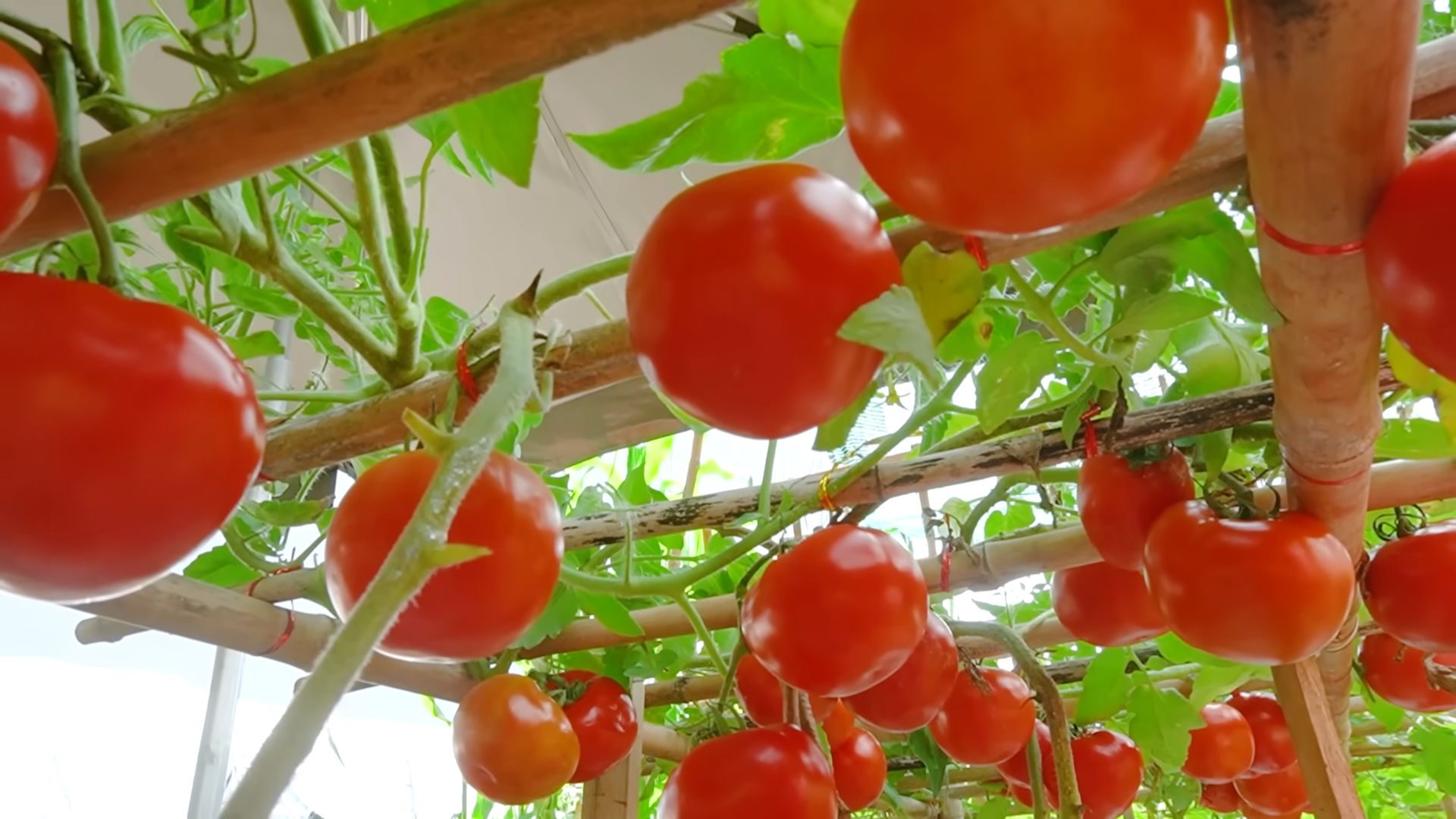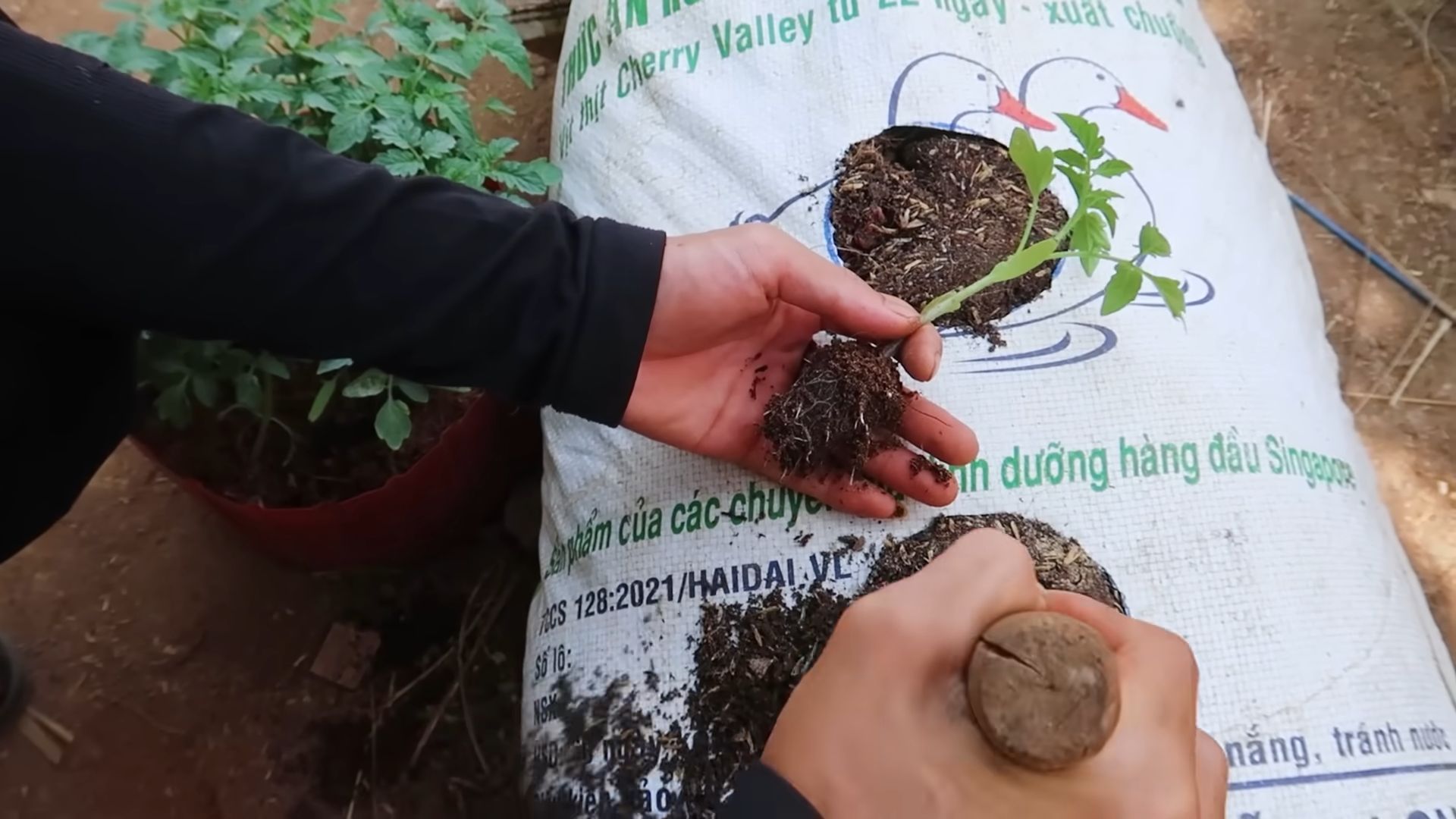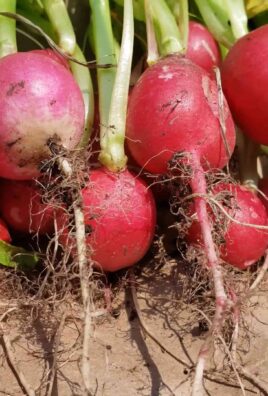Growing Tomatoes: Imagine biting into a sun-warmed, juicy tomato, bursting with flavor, that you nurtured from a tiny seed right in your own backyard. Sounds idyllic, doesn’t it? For centuries, tomatoes have been a staple in cuisines worldwide, tracing their roots back to South America and eventually captivating the palates of Europeans in the 16th century. Today, the joy of cultivating these vibrant fruits is within everyone’s reach, regardless of gardening experience!
But let’s be honest, the journey from seed to salad isn’t always smooth sailing. Many beginners face challenges like blossom end rot, pests, and lackluster yields. That’s where this beginner’s guide comes in! I’m here to share my tried-and-true tips and tricks for growing tomatoes successfully, even if you’ve never held a trowel before.
This isn’t just about planting a seed and hoping for the best. It’s about understanding the needs of your tomato plants, from choosing the right variety to providing the perfect growing conditions. With a little know-how and some simple DIY techniques, you can transform your garden into a tomato-lover’s paradise and enjoy a bountiful harvest all season long. So, grab your gardening gloves, and let’s get started!

Growing Tomatoes: Your Ultimate DIY Guide for Beginners
Hey there, fellow gardening enthusiasts! I’m so excited you’re diving into the wonderful world of growing your own tomatoes. There’s nothing quite like the taste of a sun-ripened, homegrown tomato, and trust me, it’s easier than you think! This guide is designed for absolute beginners, so don’t worry if you’ve never planted anything before. We’ll walk through everything step-by-step, from choosing the right variety to harvesting your delicious bounty.
Choosing the Right Tomato Variety
Before we get our hands dirty, let’s talk tomatoes! There are literally hundreds of varieties, and picking the right one for your space and climate is crucial.
* Determinate vs. Indeterminate: This is the big one! Determinate tomatoes grow to a certain size and produce all their fruit at once, making them great for canning. Indeterminate tomatoes keep growing and producing fruit throughout the season. I personally prefer indeterminate varieties because I love having fresh tomatoes all summer long.
* Size Matters: Do you want tiny cherry tomatoes, medium-sized slicers, or giant beefsteaks? Consider what you’ll be using them for. Cherry tomatoes are perfect for salads, slicers are great for sandwiches, and beefsteaks are ideal for grilling.
* Disease Resistance: Look for varieties that are resistant to common tomato diseases like Verticillium wilt (V), Fusarium wilt (F), and nematodes (N). These are often indicated on the seed packet or plant tag.
* Climate Considerations: If you live in a cooler climate, choose early-maturing varieties. If you have hot summers, look for heat-tolerant options.
Some of my personal favorite beginner-friendly varieties include:
* Cherry Tomatoes: Sungold (super sweet!), Sweet Million (prolific producer)
* Slicing Tomatoes: Early Girl (early and reliable), Better Boy (classic flavor)
* Paste Tomatoes: Roma (great for sauces), San Marzano (Italian favorite)
Starting Your Tomato Plants
You have two main options here: starting from seed or buying transplants. Starting from seed gives you more variety choices, but it requires a bit more time and effort. Buying transplants is quicker and easier, but you’ll have fewer options.
Starting from Seed (Indoor)
I love starting my tomatoes from seed indoors because it gives me a head start on the growing season.
1. Gather Your Supplies: You’ll need seed starting trays or small pots, seed starting mix (not regular potting soil!), tomato seeds, a spray bottle, and a grow light (optional, but highly recommended).
2. Sow the Seeds: Fill your trays or pots with seed starting mix. Moisten the mix with the spray bottle. Plant 2-3 seeds per cell or pot, about 1/4 inch deep. Gently cover the seeds with more mix.
3. Provide Warmth and Light: Cover the trays or pots with a clear plastic dome or plastic wrap to create a humid environment. Place them in a warm location (around 70-75°F). Once the seeds germinate (sprout), remove the dome and place the seedlings under a grow light or in a sunny window. If using a window, rotate the seedlings regularly to prevent them from leaning towards the light.
4. Water Carefully: Keep the seed starting mix consistently moist, but not soggy. Water from the bottom by placing the trays in a shallow dish of water and allowing the mix to absorb the water.
5. Thin the Seedlings: Once the seedlings have their first true leaves (the second set of leaves that appear after the initial seed leaves), thin them to one seedling per cell or pot. Choose the strongest, healthiest-looking seedling and snip off the others at the soil line.
6. Harden Off the Seedlings: About a week before you plan to transplant the seedlings outdoors, you’ll need to “harden them off.” This means gradually exposing them to outdoor conditions to acclimate them to the sun, wind, and temperature changes. Start by placing them outside in a sheltered location for an hour or two each day, gradually increasing the amount of time they spend outdoors.
Buying Transplants
If you’re short on time or space, buying transplants is a great option.
1. Choose Healthy Plants: Look for plants that are about 6-8 inches tall, with thick stems and healthy green leaves. Avoid plants that are leggy (tall and spindly), yellowed, or have spots on their leaves.
2. Check the Roots: Gently remove the plant from its pot and inspect the roots. They should be white or light brown and not circling tightly around the pot.
3. Harden Off the Transplants: Even if you buy transplants, it’s still a good idea to harden them off for a few days before planting them in the ground.
Preparing Your Garden Bed
Tomatoes need at least 6-8 hours of sunlight per day and well-drained soil.
1. Choose a Sunny Location: Select a spot in your garden that gets plenty of sunlight.
2. Prepare the Soil: Tomatoes prefer slightly acidic soil with a pH of 6.0-6.8. Amend the soil with compost or other organic matter to improve drainage and fertility. I like to add a handful of bone meal to each planting hole to provide phosphorus, which promotes strong root growth.
3. Consider Raised Beds: If your soil is poor or poorly drained, consider growing your tomatoes in raised beds.
Planting Your Tomato Plants
Now for the fun part!
1. Dig the Holes: Dig holes that are deep enough to bury the bottom third of the tomato plant’s stem. This encourages the plant to develop more roots along the buried stem, resulting in a stronger, healthier plant.
2. Plant Deep: Gently remove the tomato plant from its pot and loosen the roots. Place the plant in the hole and backfill with soil.
3. Water Thoroughly: Water the newly planted tomatoes thoroughly.
4. Add Support: Tomatoes need support to prevent them from falling over as they grow. You can use stakes, cages, or trellises. I prefer using tomato cages because they’re easy to install and provide good support. Place the support around the plant immediately after planting.
5. Mulch: Apply a layer of mulch around the tomato plants to help retain moisture, suppress weeds, and regulate soil temperature. I like to use straw or shredded leaves.
Caring for Your Tomato Plants
Consistent care is key to a successful tomato harvest.
1. Water Regularly: Water your tomato plants deeply and regularly, especially during hot, dry weather. Aim to water at the base of the plant to avoid wetting the foliage, which can lead to disease.
2. Fertilize: Tomatoes are heavy feeders, so they need regular fertilization. Use a balanced fertilizer (e.g., 10-10-10) or a tomato-specific fertilizer according to the package directions. I like to fertilize every 2-3 weeks.
3. Prune: Pruning can help improve air circulation and encourage fruit production. Remove suckers (the small shoots that grow between the main stem and the branches) from indeterminate tomato varieties. Determinate varieties generally don’t need pruning.
4. Pest and Disease Control: Keep an eye out for common tomato pests like aphids, tomato hornworms, and whiteflies. Handpick pests or use insecticidal soap if necessary. Prevent diseases by providing good air circulation, avoiding overhead watering, and using disease-resistant varieties.
5. Monitor for Blossom End Rot: Blossom end rot is a common problem that causes the bottom of the tomato to turn black and leathery. It’s usually caused by calcium deficiency, which can be due to inconsistent watering or poor soil. Ensure consistent watering and consider adding calcium to the soil.
Harvesting Your Tomatoes
The moment you’ve been waiting for!
1. Wait for Ripeness: Tomatoes are ripe when they are fully colored and slightly soft to the touch.
2. Harvest Gently: Gently twist or cut the tomato from the vine.
3. Enjoy! There’s nothing quite like the taste of a fresh, homegrown tomato. Enjoy them in salads, sandwiches, sauces, or just eat them straight off the vine!
Troubleshooting Common Tomato Problems
Even with the best care, you might encounter some problems along the way. Here are a few common issues and how to address them:
* Yellowing Leaves: This could be due to nutrient deficiency, overwatering, or disease. Check the soil drainage and fertilize if necessary.
* Blossom Drop: This is when the flowers fall off the plant without producing fruit. It can be caused by extreme temperatures, lack of pollination, or stress. Ensure consistent watering and try hand-pollinating the flowers.
* Cracked Tomatoes: This is usually caused by inconsistent watering. Water regularly and deeply, especially during dry spells.
Growing tomatoes is a rewarding experience, and I hope

Conclusion
So, there you have it! A comprehensive guide to successfully growing tomatoes, even if you’re a complete beginner. We’ve covered everything from selecting the right variety and preparing your soil to providing essential care and troubleshooting common problems. But why is this DIY approach to growing tomatoes a must-try?
Simply put, growing your own tomatoes offers a level of freshness and flavor that you just can’t find in store-bought produce. Imagine biting into a sun-ripened tomato, still warm from the garden, bursting with juicy sweetness. That’s the reward waiting for you. Beyond the taste, you’ll also have the satisfaction of knowing exactly where your food comes from and that it’s free from harmful pesticides and chemicals. It’s a healthier, more sustainable, and ultimately more rewarding way to enjoy this versatile fruit.
This guide isn’t just about following instructions; it’s about empowering you to take control of your food source and connect with nature. The process of nurturing a tiny seed into a thriving plant that yields delicious fruit is incredibly fulfilling. It’s a learning experience that can be enjoyed by people of all ages and skill levels.
Ready to take your tomato growing to the next level? Consider experimenting with different tomato varieties to find your favorites. Try heirloom tomatoes for unique flavors and colors, or opt for disease-resistant varieties if you live in an area prone to tomato blight. You can also explore different growing methods, such as container gardening or vertical gardening, to maximize your space and yield.
Another variation to consider is companion planting. Basil, for example, is a classic companion plant for tomatoes, as it is believed to improve their flavor and repel pests. Marigolds are also excellent for deterring nematodes, which can damage tomato roots.
Don’t be afraid to get creative and adapt these techniques to suit your specific needs and preferences. The most important thing is to have fun and enjoy the process of growing your own tomatoes.
We encourage you to embark on this exciting journey and experience the joy of harvesting your own homegrown tomatoes. Share your experiences with us! Let us know what varieties you’re growing, what challenges you’ve faced, and what successes you’ve celebrated. Post pictures of your tomato plants and your delicious harvests on social media using #HomegrownTomatoes and #BeginnerGardening. We can’t wait to see what you create! Remember, with a little patience and dedication, you can enjoy a bountiful harvest of delicious, homegrown tomatoes all season long. This **growing tomatoes** guide is just the beginning of your gardening adventure!
Frequently Asked Questions (FAQ)
Q: What is the best time to start growing tomatoes from seed?
A: The best time to start growing tomatoes from seed depends on your local climate and the length of your growing season. In general, you should start seeds indoors 6-8 weeks before the last expected frost. This allows the seedlings to develop a strong root system before being transplanted outdoors. To determine the last frost date for your area, consult your local weather service or gardening resources. You can also use a seed starting calendar to help you plan your planting schedule. Remember to harden off your seedlings gradually before transplanting them outdoors to acclimate them to the outdoor conditions.
Q: What kind of soil is best for growing tomatoes?
A: Tomatoes thrive in well-drained, fertile soil that is rich in organic matter. The ideal soil pH for tomatoes is between 6.0 and 6.8. Before planting, amend your soil with compost, aged manure, or other organic materials to improve its drainage, fertility, and water-holding capacity. Avoid heavy clay soils, as they can become waterlogged and suffocate the roots. If you have clay soil, consider growing your tomatoes in raised beds or containers filled with a well-draining potting mix. You can also perform a soil test to determine the nutrient levels in your soil and amend it accordingly.
Q: How often should I water my tomato plants?
A: Tomato plants need consistent watering, especially during hot, dry weather. Water deeply and regularly, aiming to keep the soil consistently moist but not waterlogged. The frequency of watering will depend on factors such as the weather, soil type, and size of the plant. As a general rule, water your tomato plants when the top inch of soil feels dry to the touch. Avoid overhead watering, as this can promote fungal diseases. Instead, water at the base of the plant, using a soaker hose or drip irrigation system. Mulching around the base of the plant can also help to retain moisture and suppress weeds.
Q: What are some common tomato pests and diseases, and how can I prevent them?
A: Tomatoes are susceptible to a variety of pests and diseases, including aphids, whiteflies, tomato hornworms, blossom end rot, early blight, and late blight. To prevent these problems, practice good garden hygiene, such as removing weeds and debris from around your tomato plants. Use disease-resistant tomato varieties whenever possible. Inspect your plants regularly for signs of pests or diseases, and take action promptly if you notice any problems. You can use organic pest control methods, such as insecticidal soap or neem oil, to control aphids, whiteflies, and other pests. To prevent blossom end rot, ensure that your tomato plants receive consistent watering and adequate calcium. For fungal diseases, such as early blight and late blight, apply a fungicide according to the manufacturer’s instructions.
Q: How do I prune my tomato plants?
A: Pruning tomato plants can help to improve air circulation, reduce disease, and promote fruit production. The best way to prune tomatoes depends on the type of tomato plant you are growing. Determinate tomato plants, which grow to a certain size and then stop, require minimal pruning. Simply remove any suckers (small shoots that grow between the main stem and the branches) that appear below the first flower cluster. Indeterminate tomato plants, which continue to grow and produce fruit throughout the season, require more extensive pruning. Remove all suckers that grow below the first flower cluster, and then prune the remaining suckers to maintain a single main stem. You can also prune some of the lower leaves to improve air circulation and prevent disease.
Q: When is the best time to harvest tomatoes?
A: The best time to harvest tomatoes is when they are fully ripe and have reached their mature color. The color will vary depending on the variety of tomato you are growing. Gently squeeze the tomato to test for ripeness. A ripe tomato will be slightly soft to the touch but not mushy. Harvest tomatoes in the morning, when they are cool and firm. Avoid harvesting tomatoes during hot, sunny weather, as they can be more susceptible to bruising. To harvest a tomato, gently twist it off the vine, leaving a small piece of stem attached. Store ripe tomatoes at room temperature, away from direct sunlight. Do not refrigerate tomatoes, as this can affect their flavor and texture.





Leave a Comment